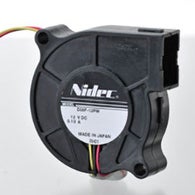NIDEC's Technical Capabilities
Types and features of Nidec’s fan motors
Nidec has been producing brushless DC motor-based fan motors – products that generate wind, transfer heat, and generate pressure – at full scale since 1982. With a wide range of product lineup, and thanks to the product-developing technology supported by supercomputer-based fluid analysis and other elements, and the long-accumulated knowhow of cost-reducing production technology cost, Nidec’s fan motors are used in a variety of businesses.
This section features fan motors’ roles, major applications, and types.
The three roles of the fan motor
Fan motors are installed in devices that require “heat transfer,” “material transfer,” and “pressure difference.”
Heat transfer
Heat transfer is required in, for example, telecommunication devices, office automation equipment, and gaming consoles. Some devices require direct cooling, with a strong wind applied to the CPU and other heat-generating devices, while other devices exhaust heat remaining inside devices. Reliability is required for servers and other devices that operate around the clock, and the reliability is must be high enough to ensure for the device to rotate for as long as seven to eight years. On the other hand, low-level noise is a priority for gaming consoles and home appliances. At Nidec, we combine highly quite motors with low-noise blade dimensions and designs to create quiet products.
Material transfer
The term “material transfer” means to transfer particles and molecules of water vapor, smell, etc. Some rice cookers are equipped with a function to force extra water vapor to be exhausted from inside the rice steamer, enabling rice to become fluffy when baked. In addition, a strong fan is attached to toilets with an odor-eliminating function. By blowing out inhaled air in high static pressure, the machine lets the air pass through a filter to remove odor.
Pressure difference
Pressure difference is used in copy machines and other products. By adjusting air volume and static pressure, the machine absorbs and sends over copy paper forward during a printing process, and places a sheet over another in an output tray.
Nidec’s fans in categories
Nidec’s fan motors can be divided into two categories. See below for their structures and mechanisms.
Axial fan
The axial fan, also known as the propeller fan, has a motor-driven shaft with a propeller. This component takes the air in, and pushes it out to a direction in parallel to the shaft. Since it is possible to secure a wide propeller diameter, the axial fan can migrate a large volume of air effectively and efficiently, to cool a heat source, or ventilate space. The axial fan has another feature of being power-efficient.

Centrifugal fan (blower)
The centrifugal fan, also known as the centrifugal blower, has a motor-driven impeller inside the housing, and blows in centrifugally as the axially installed blades rotate. The fan applies a strong pressure to exhaust air with a focus on the vent. As it can blow in air by taking aim, the centrifugal fan is suitable for cooling specific components of electronic devices, which generate more heat than other products.

Recent years are witnessing computers and home appliances advance at an accelerating pace, and the amount of heat from such products continues to grow. Fan motors, which are essential in cooling them, are used in a growing number of areas and in increasingly diverse applications. It is due to these market trends that fan motors are required to possess a high cooling performance and low-level noise.
Nidec continues to offer high-air-capacity, low-noise, and high-efficiency fan motors that are developed from conventional products. The fan motors we offer are low in noise and vibration, eco-friendly, and capable of meeting any and all market needs.

